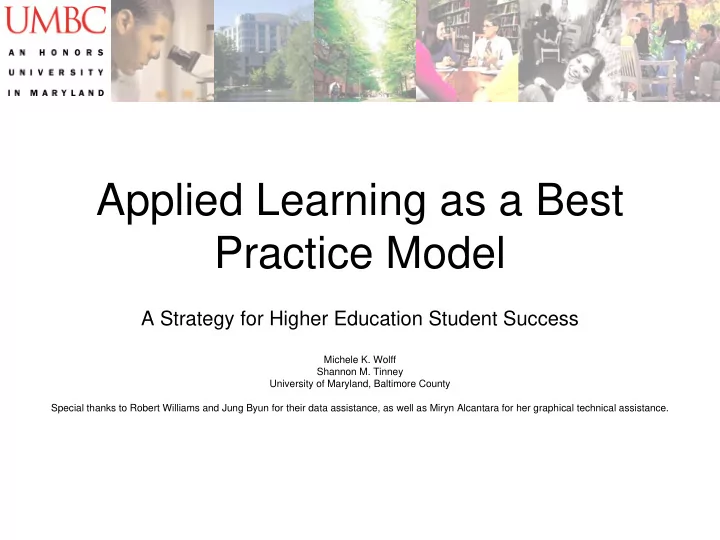

Applied Learning as a Best Practice Model A Strategy for Higher Education Student Success Michele K. Wolff Shannon M. Tinney University of Maryland, Baltimore County Special thanks to Robert Williams and Jung Byun for their data assistance, as well as Miryn Alcantara for her graphical technical assistance.
Background & Context… …The Good What is Applied or Experiential Learning? • Activities that engage the learner directly in the phenomena being studied and are associated with structured reflection on the connection between the phenomena and theoretical concepts (Kendall, 1990, 181). • Viewed as pedagogy; practical application of resources; mechanism for citizenship development
Background & Context… Benefits of this approach • Increased student exposure, awareness, understanding of traditions and cultures different from their own • Students as creators of knowledge • Skill acquisition and development • Increased interest and excitement about learning • Supports research and teaching of faculty
Background & Context… Which of the following activities is not traditionally viewed as applied learning? Cooperative Education Internship Performance Resident Hall Assistant Research Service-Learning Study Abroad
Background & Context… …The Bad: Higher Education Student Persistence: Is There a Problem? 100% NATIONAL/PEER 82% UMBC 70%-72% 80% 63%-66% 55% approximately 60% 50% of students who enter college to 40% earn a bachelor's degree fail to complete their degree in 6 years 20% 0% FIRST YEAR 6-YR RETENTION GRADUATION
Reframing Retention & Graduation Rates Making The Bad Not See So Bad Student Success Focuses on Strategies to: • Prevent departure/attrition • Promote overall success developmentally and academically
A Theoretical Perspective Student Involvement Theory What is student involvement? “The amount of physical and psychological energy that the student devotes to the academic experience” (Astin, 1984).
Student Involvement Theory • What is Astin’s Student Involvement Theory? The greater a student’s involvement, the greater his/her level of personal development and student learning (or higher levels of affective and cognitive development)
Student Involvement Theory Postulates and Assumptions Cognitive Outcomes Policy & Involvement Practices Affective Outcomes
Theoretical Model Applied Learning, Development & Student Success Affective + Development Student + Applied Success: Learning Persistence Cognitive + Development
Applied Learning, Involvement & Student Success Special Programs Exploratory Study: The effect of applied learning on undergraduate retention and graduation rates 2-year Retention Rate 6-year Graduation Rate 100% 100% 88.7% 83.7% 80% 70.2% 80% 60% 60% 45.7% 40% 40% 20% 20% 0% 0% Non-applied Learning Applied Learning Non-applied Learning Applied Learning
Research Questions • What is the impact of different types of applied learning on seniors’ affective & cognitive development? • How is student development related to degree completion? • What are the relationships among applied learning, student development, and degree completion?
Methodology • Data & Sample – 2004 National Survey of Student Engagement (NSSE) • Web-based survey administered by NSSE • Response rate (SR) = 36% – Senior-level Students • 12 - 24 credits of graduating (n = 328)
Methodology Dependent Variables • Graduated (yes/no) • Time to Degree (in years at this institution)
Methodology Independent Variables • Applied Learning Experiences (yes/no) – Professional practice – Community service – Research – Study abroad program – Service-learning • Multiple applied learning experiences
Methodology Mediating Variables • Cognitive Development ( α = .88; 10 items ) • Affective Development ( α = .84; 6 items) • Principal components factor analysis and reliability analysis were conducted for each scale • Mean scaled scores were created
Methodology Control Variables • Student Demographics – Gender – Race – Non-traditional college student (> 25 yrs.) – First-generation college – Enrollment status (FT/PT) – Transfer student – Major program area (STEM v. non-STEM) – Dorm resident – In-state residency – Cumulative GPA
Bivariate Relationships between Applied Learning, Student Development & Degree Completion Affective Cognitive Graduated Time to Development Development Degree Professional + + - Practice Community + + + service Research Study Abroad Service-learning + Multiple applied + + + - experiences Affective --- --- development Cognitive --- --- development
Multivariate Analyses Applied Learning, Student Development & Degree Completion • Bivariate relationships between applied learning and reports of cognitive & affective development remained significant when controlling for student characteristics.
Multivariate Analyses Applied Learning, Student Development & Degree Completion • Senior-level students who had completed a professional practice experience were significantly more likely to graduate in less time than seniors who reported not having completed such an experience. • Senior-level students who engaged in more applied learning experiences were significantly more likely to graduate in a shorter period of time than those who did not.
Implications Implementation & Next Steps • Promote the institutionalization of applied learning as part of undergraduate education enhancement – Creating an “honors university experience” for every student – Applied learning as graduation requirement – Effectiveness & Efficiency Initiative • Dissemination as a best practice for adaptation/implementation of applied learning as an active learning curriculum component
Limitations of Current Research • Used a sample of senior-level students • Focused on multi-item indicators of cognitive and affective development instead of individual components
Directions for Future Research • Incorporate Alumni Survey to enhance current research • Longitudinal retention and graduation analysis
Directions for Future Research • Tinto’s interactionist theory of student departure • Pilot study of impact of applied learning on affiliated versus non-affiliated student success
QUESTIONS?
Recommend
More recommend